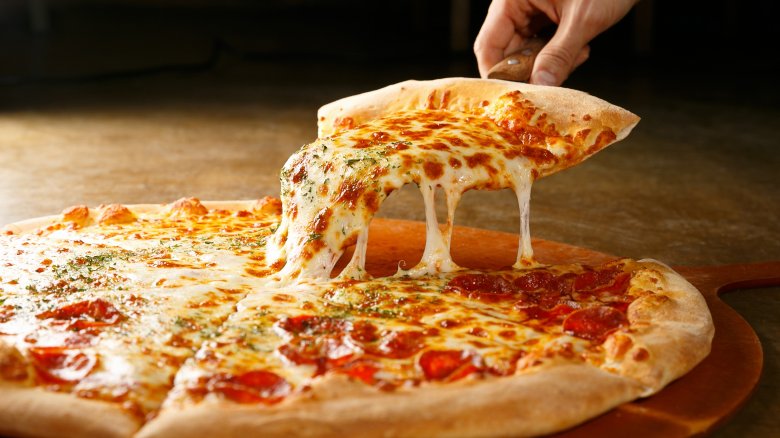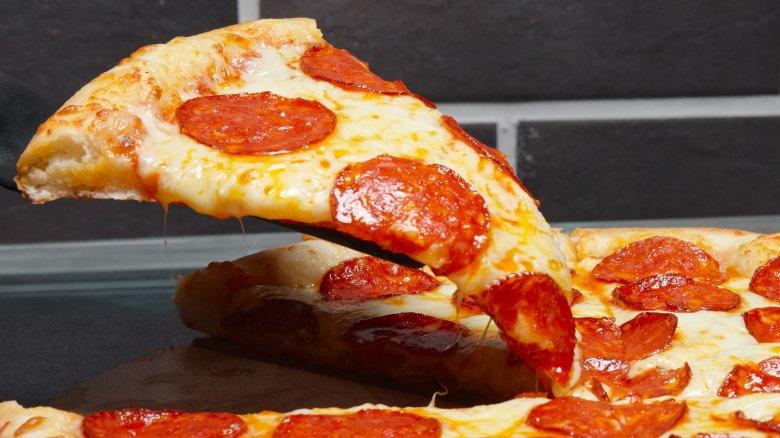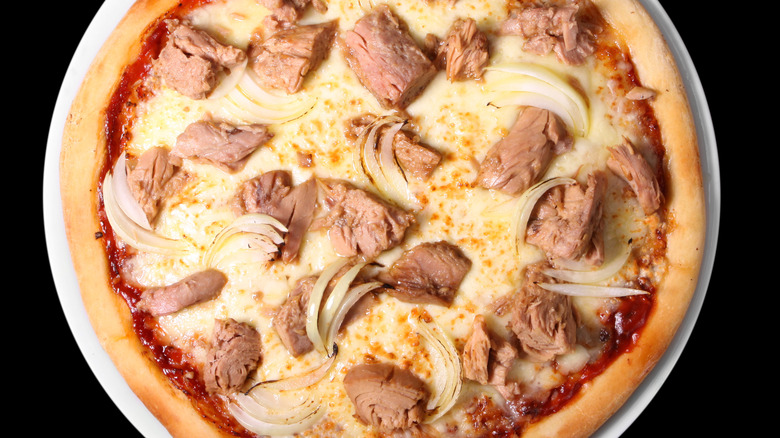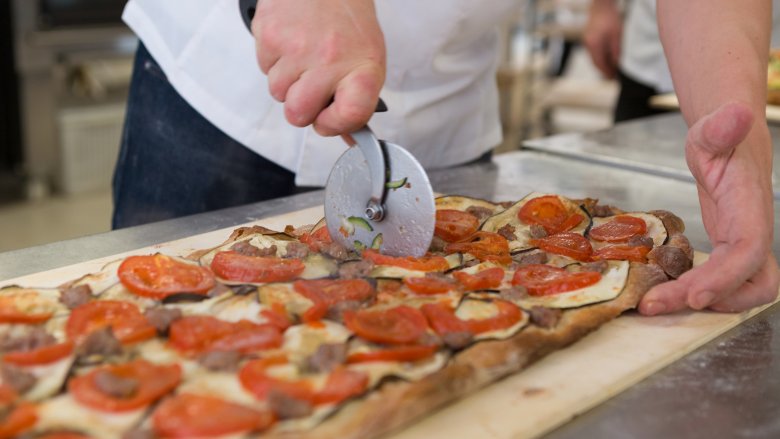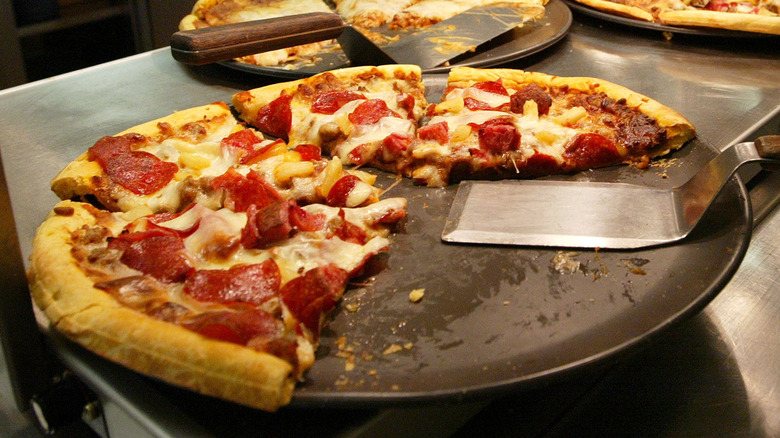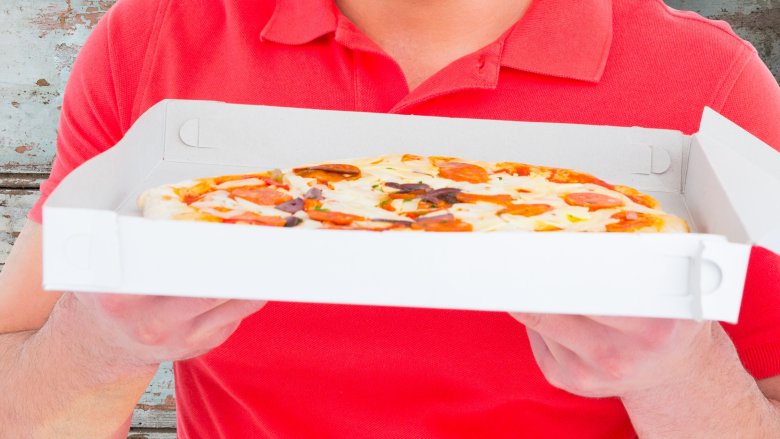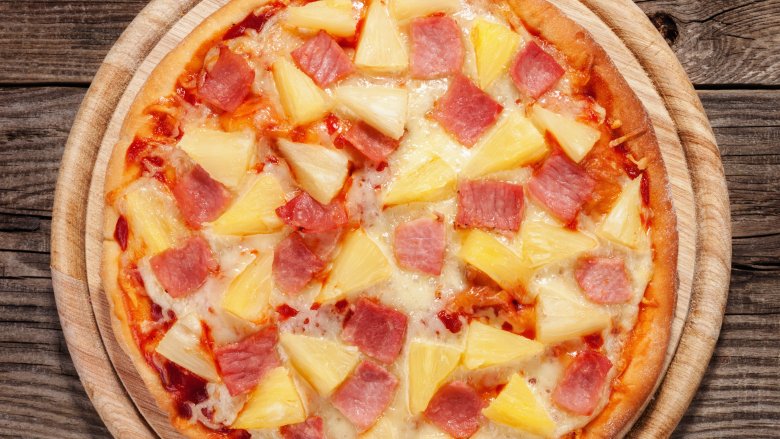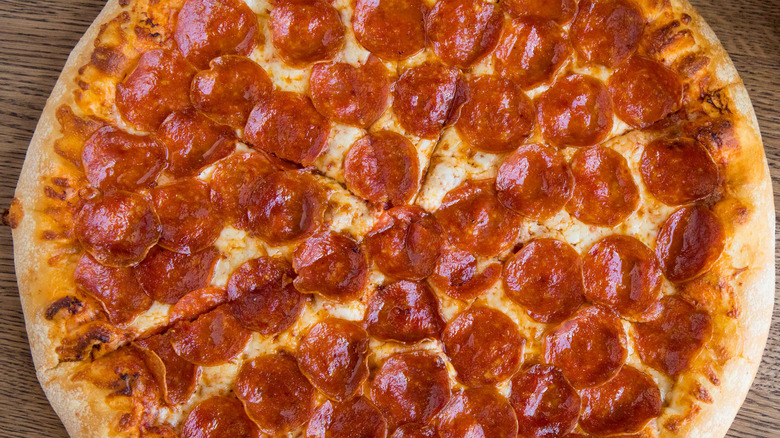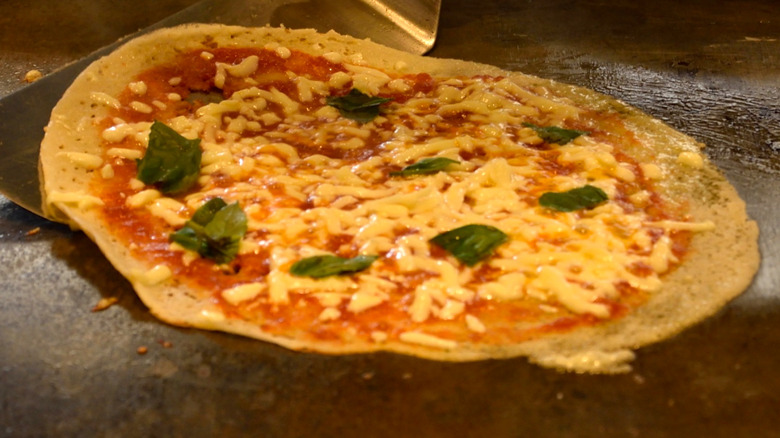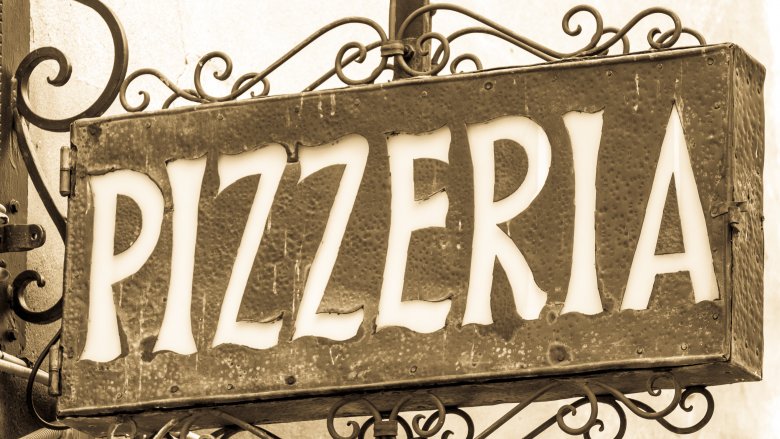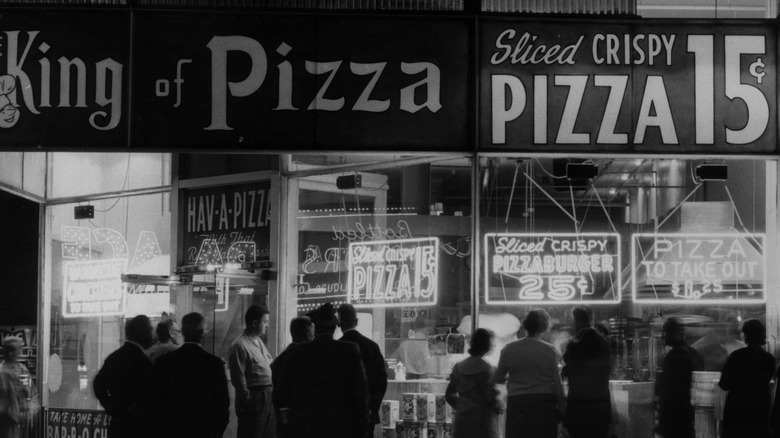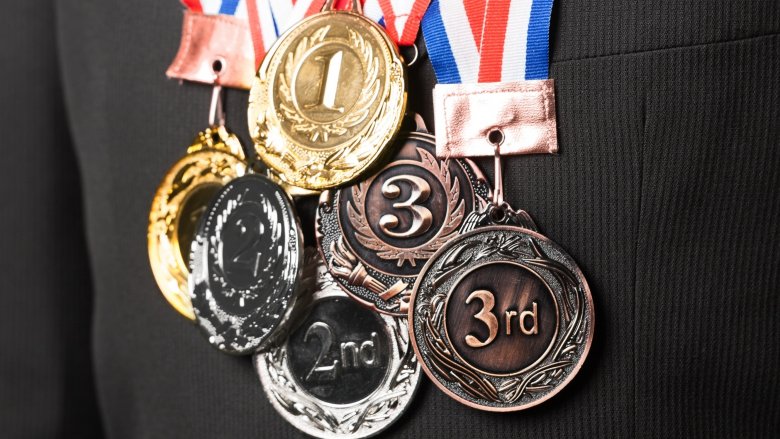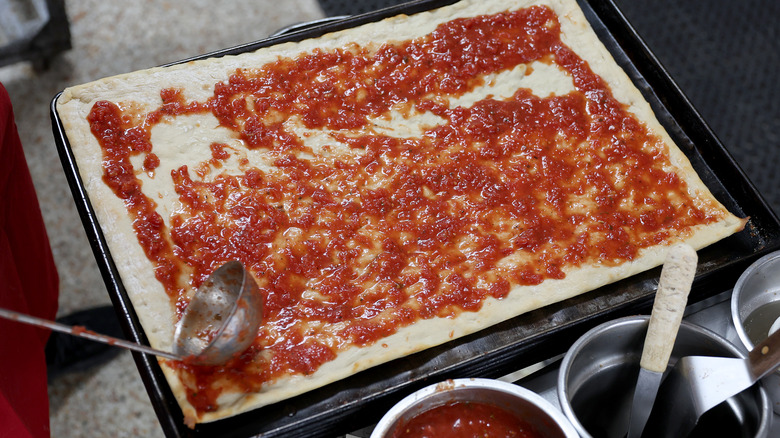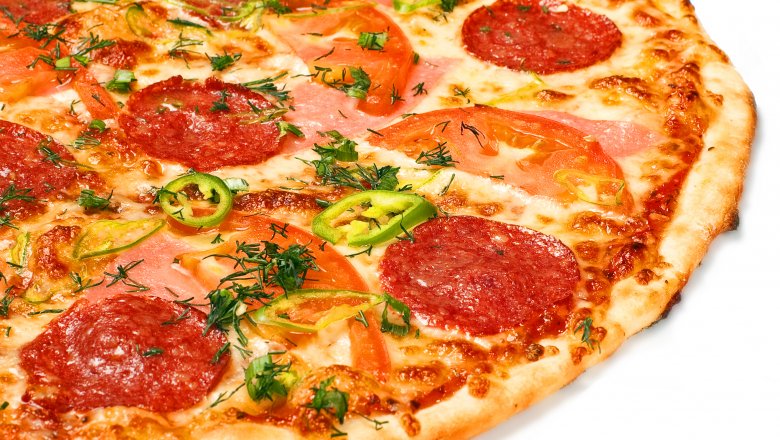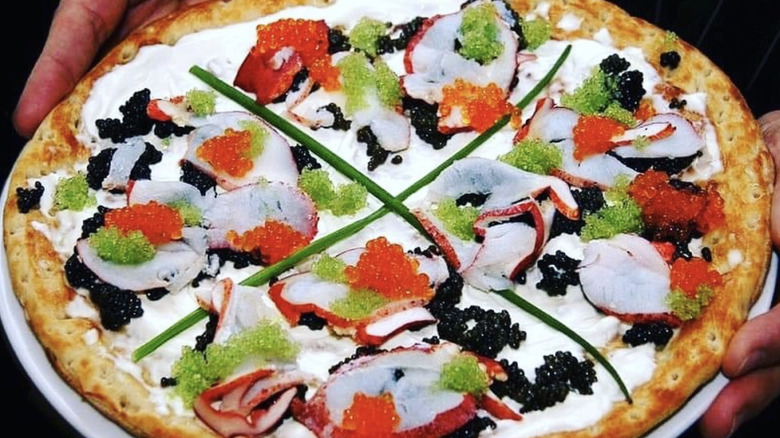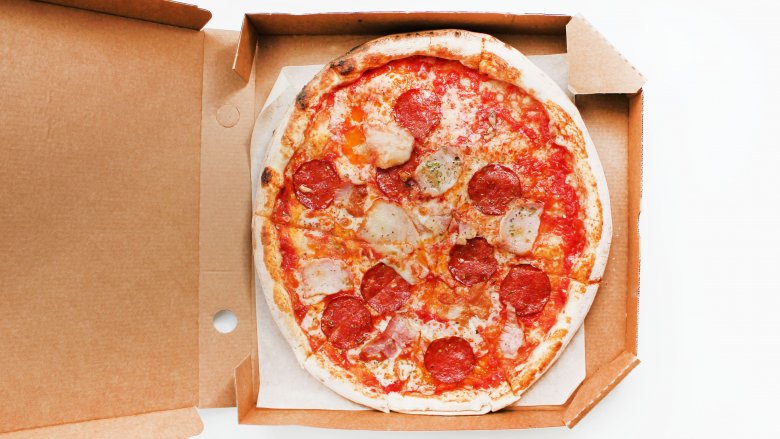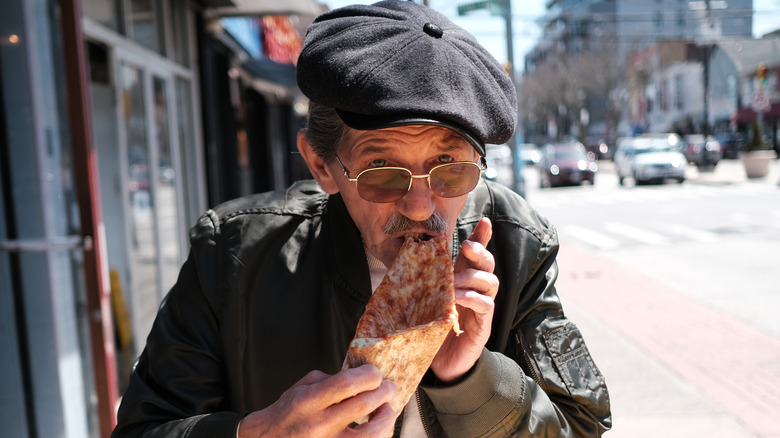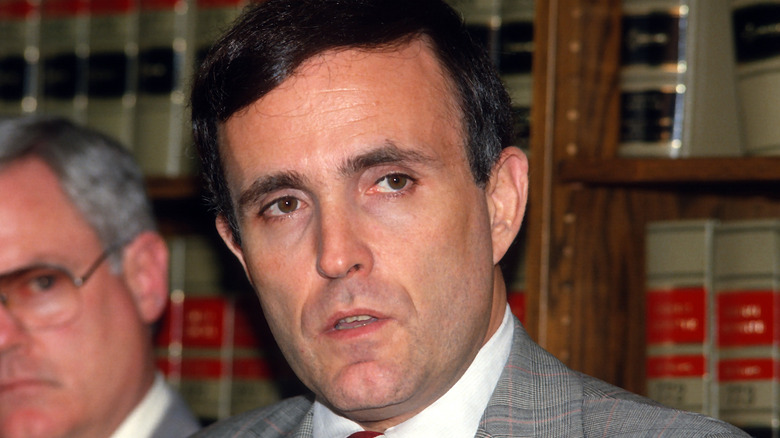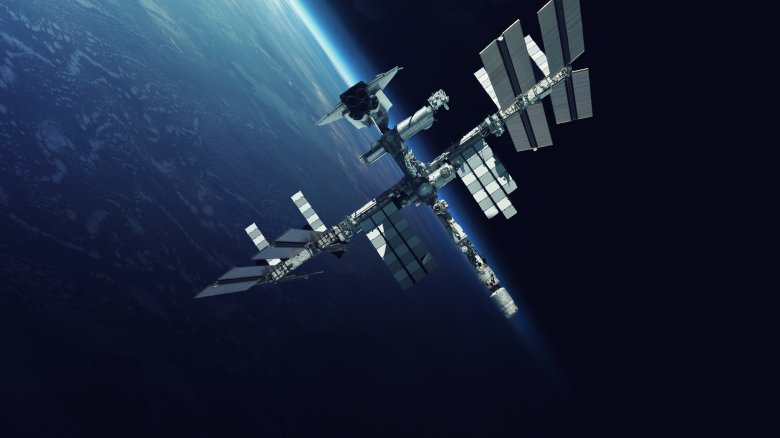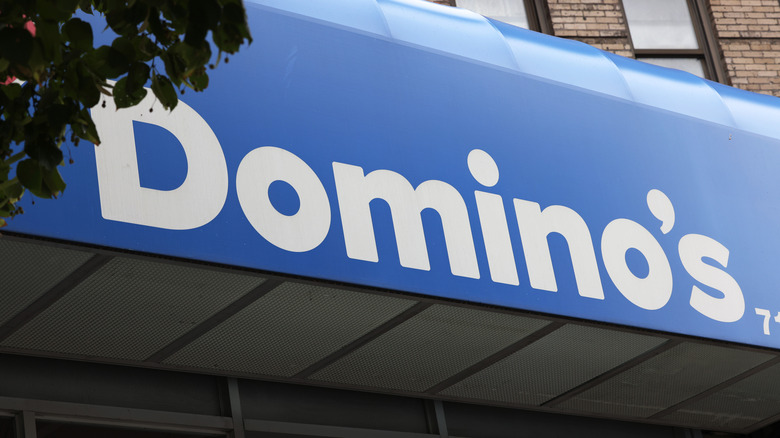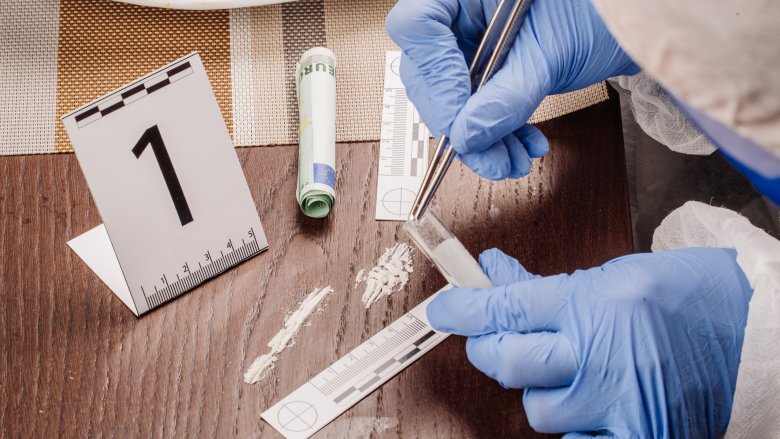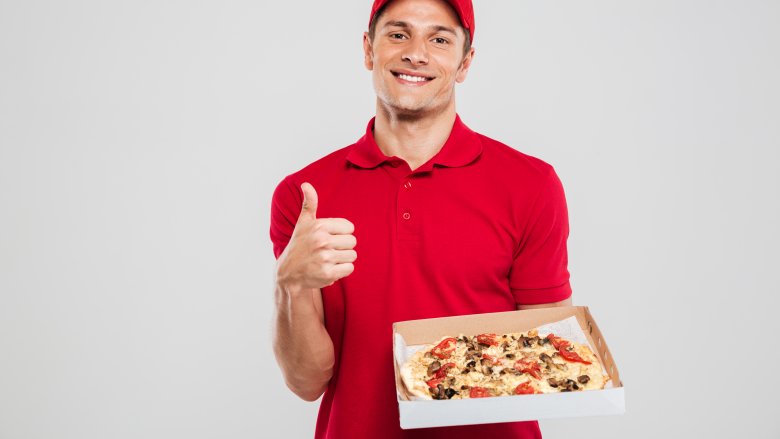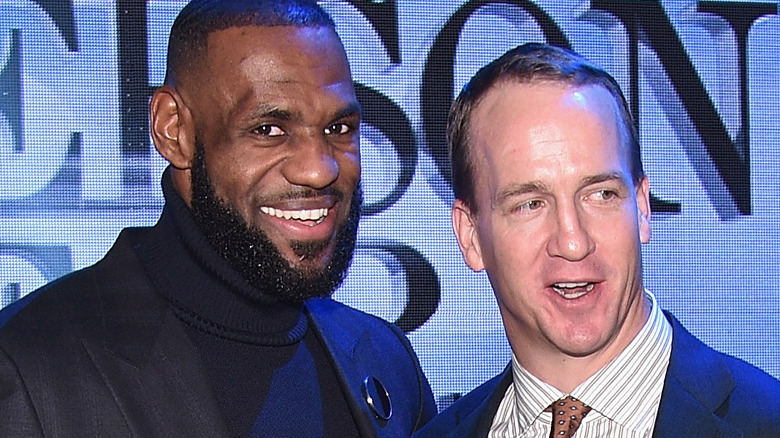The Untold Truth Of Pizza
We may receive a commission on purchases made from links.
It's hard not to love the cheesy doughy deliciousness of pizza. It's the perfect example of a food that's greater than the sum of its parts, with simple bread, sauce, and cheese coming together to create something truly extraordinary. Whether you're into New York-style thin crust, Chicago deep-dish, Detroit pan pizza, or any of the other unique regional styles, we bet there's some type of pizza you hold close to your heart.
Americans can't get enough pizza, ordering over $45 billion worth in 2021 (via Statista). It's beloved by intoxicated college students, children, fancy Italian chefs, and basically everyone else. But as much as you love pizza, how much do you really know about it? Pizza has a long history with plenty of unexpected twists and turns. There are many surprising facts to be discovered about this simple comfort food. Here are the most scrumptious secrets pizza has to tell.
Americans eat even more pizza than you thought
Americans love their pizza. In fact, 350 slices of pizza are eaten in the U.S. every second. The average American eats 46 slices of pizza per year, and 3 billion pizzas are sold in the U.S. every single year (via The Washington Post). That is a lot of cheese and sauce!
Favorite pizza toppings vary greatly around the world
Pizza originated in Italy, and companies based in the United States rule the pizza industry, but the savory pie is truly a global dish. Palates, preferences, tastes, and ingredient availability are different all over the world, and as such, what people prefer for their pizza toppings varies a lot from country to country.
According to Snopes, Swedes are fans of Tropicana pizza, which comes topped with pineapple, sliced bananas, and curry powder. Dessert pizza is quite popular in Brazil, according to Pry's World, while thunfisch, or tuna (from a can) gets pizza-lovers excited in Germany (via The Cultured Cook). Mayonnaise is beyond commonplace on pizzas at most every quality and price level in Japan (according to Uncut Recipes), while in Russia, a popular preparation is mockba pizza, which includes sardines, salmon, tuna, mackerel, herring, and onions (via How Stuff Works). Dogtown Pizza says that in Costa Rica, coconut is a popular topping choice, as is shrimp. In Iceland, reindeer are abundant and so is reindeer meat, so much so that even Domino's serves it on pizza there, according to the Austin Chronicle.
There's a secret pizza language
You may be surprised to learn that pizza makers speak a secret pizza language. You know how sometimes you pick up a slice of pizza and all of the toppings slide off? That's called an avalanche. The leftover pizza crusts on a plate are known as bones, and soggification is when the pizza dough gets soggy from too much sauce or condensation.
If you're ever getting a pizza and you hear the words "Reggie alert," that means they think you're a tourist and are preparing for the worst. Prove them wrong by ordering quickly and cleaning up your table when you're done eating.
The meaning of pizza
Pizza is essentially flat bread, topped with savory ingredients, and that's a culinary idea in many cultures which dates back centuries. According to the Online Etymology Dictionary, they ate such flatbreads in Armenia, Greece, and ancient Rome — the precursor to the modern nation of Italy, the place most associated with pizza. A number of these food traditions, and the local names for them, likely played a role in the dish acquiring its Italian name.
A 1907 Italian language etymology guide states that the word pizza is derived from pinza, an Italian expression that means "clamp," itself coming from the Latin word pinsere, or "to pound," evoking imagery of pizza cooks working and kneading dough. Pizza is also a kind of pie, and so the name could also come from pitta, an old Greek word for pie. There's also the Old High German word pizzo, which means "bite" or "piece," hinting at how pizza is sliced into individual servings.
Pizza has been used as a weapon
Think the only thing that's dangerous about pizza is the fat content? Think again. When challenged by armed robbers in Miramar, Florida, a smart pizza delivery man used a large pepperoni pizza as a weapon.
He threw the hot pizza at his assailants and ran away. One shot was fired as he fled, but he was able to get away safely. The three teenage robbers weren't as lucky. They were later arrested and charged with armed robbery.
The Hawaiian pizza was invented in Canada
Even though the ham and pineapple topped pizza is dubbed a Hawaiian, it wasn't invented by a Hawaiian — or even someone from a tropical location.
The inventor of the Hawaiian pizza, Sam Panopoulos, is actually a Greek man who opened a pizza restaurant in Canada. One day in 1962, he was searching for inventive pizza toppings when he decided to open a can of pineapple. In that moment, he birthed one of the most controversial pizza topping combinations ever.
In fact, it's so controversial that heads of state have commented on it. In February 2017, Iceland's president, Gudni Thorlacius Johannesson, said he wanted to ban pineapple on pizza. He later retracted the statement in a Facebook post. Canadian Prime Minister Justin Trudeau responded by tweeting "I have a pineapple. I have a pizza. And I stand behind this delicious Southwestern Ontario creation. #TeamPineapple"
What pizza toppings are the most popular in the US?
Across the thousands of franchised and independent pizza joints that fill the American culinary landscape, a certain suite of toppings have emerged as the de facto ingredients. Among those are cured and spiced meats, mild vegetables, and pineapple.
In conjunction with the celebration of National Pizza Day in February 2021, YouGov conducted a survey to find out which well-known pizza toppings are actually the most popular, and which are apparently the favorite of next to no one. In the poll of 6,000 adults, the number one vote-getter was pepperoni, with 64% of respondents naming the salty and sliced red processed meat as their favorite thing to put on a pizza. Next on the list, with 56% and 54%, respectively, were crumbled sausage and mushrooms. Just over half of Americans prefer extra cheese on their pizza, and just under half love onions. The least popular pizza topping is almost as disliked as pepperoni is beloved. The most-hated ingredient, with 61% of survey respondents calling it their most avoided, was anchovies.
NASA's 3D printer can make pizza in less than 5 minutes
NASA has accomplished many incredible things. They sent a man to the moon, invented Super Soakers, and made the International Space Station. But one of their most interesting inventions is a 3D printer that makes pizza in under five minutes.
The printer is called the BeeHex and can produce any type of pizza in any shape — even in the shape of Donald Trump's head. Apparently the crust is very thin, though, so you need to scarf that pizza down quickly before it gets cold.
When was the first pizza made?
Romans ate pizza-like foods in antiquity. Virgil's epic poem "The Aeneid" includes a playful scene wherein a group of soldiers use "thin wheaten cakes" as makeshift plates and cover them in foraged mushrooms and herbs. It all tastes so good that they go ahead and eat those "plates" (via History Today).
By the late 1700s, according to First We Feast, pizza had firmly taken hold as a basic meal in Naples, sold cheaply to laborers. Vendors sold essentially two types: one topped with tomatoes, anchovies, and oregano, and one with garlic and a spice blend. And rather than working in shops or stands, pizza sellers carried around big boxes of whole pizzas and would cut off however much a worker wanted. As Italy wasn't yet a unified nation and more a collection of different states with their own dialects and culinary customs, pizza was almost entirely unknown outside of Naples for two centuries, with the first modern pizza — baked dough covered in a crushed tomato sauce with mozzarella cheese and basil — developing in the Neapolitan region in the 1800s.
The first U.S. pizza shop is still in operation in New York
If you want a slice of authentic New York pizza, head to Little Italy in Manhattan. Lombardi's, the first pizza joint in the U.S., opened its doors in 1905 on Spring Street, and it remains there to this day. Its pizza, baked in the same oven they used in 1905, is simple, with just fresh mozzarella and basil topping the red sauce.
In 2015, Lombardi's celebrated its 110th anniversary by selling pizza at the 1905 price of five cents a pie — there was a line down the street.
Pizza's popularity grew after World War II
Outside of enclaves and urban areas with large Italian populations following the immigration boom of the late 19th and early 20th centuries, pizza was a very obscure food in the United States, according to First We Feast. That all changed with World War II. Tens of thousands of Americans who served in the military and fought in the European Theater of Operations experienced pizza while they were stationed in and around Italy. In particular, Naples, the Italian city recognized as the traditional birthplace of what we recognize as modern pizza, was where American intelligence agents undertook operations.
When soldiers and officers returned home en masse after the war's end in 1945, they brought with them a taste and demand for pizza, which somewhat baffled Italian restaurant owners, who considered pizza a working-class street food. Nevertheless, by the 1950s, pizza parlors had sprung up around the country and the food had become entrenched in the United States.
There's a pizza Olympics
If you would love to be in the Olympics but are hopelessly unathletic, you'll be excited to learn about a different kind of international competition — the World Pizza Games. Events include Freestyle Acrobatic Dough Tossing, Largest Dough Stretch, and Fastest Pizza Box Folding. Competitors, called pizzaiolos, receive cash prizes for coming in first place.
Macaulay Culkin started a pizza-themed cover band
Remember Macaulay Culkin, the cute kid from "Home Alone?" Well, he moved on to another creative endeavor, namely starting a band called The Pizza Underground that was active from 2013 to 2016. His band took The Velvet Underground songs and changed the lyrics to make them about pizza.
The band's songs include "Papa John Says," "I'm Beginning to Eat the Slice" and "All the Pizza Parties." Watch Culkin and his bandmates decked out in sunglasses, singing in front of a pizza background, with slices hanging from the ceiling.
Could eating pizza lower the risk of cancer?
Pizza probably isn't the first thing that comes to mind on the subject of healthy food — most are absolutely loaded with saturated fat, sodium, and calories, after all. And yet, it may be a valuable tool in the fight to prevent certain types of cancer, per the BBC. According to a study by the Mario Negri Institute for Pharmaceutical Research in Milan (a city in Italy, the birthplace of pizza), subjects who ate pizza one or more times a week experienced fewer instances of cancer. More than 3,000 people who had developed throat, colon, esophageal, and mouth cancers, and 5,000 who had not, were surveyed on their eating habits, particularly when it came to the frequency with which they ate pizza. The more voracious pizza-eaters experienced 59% less esophageal cancer, 26% less colon cancer, and 34% less mouth cancer.
Researchers believe that the key factor here might be pizza sauce, made from tomatoes, which contain a naturally-occurring chemical called lycopene. It's what makes tomatoes red, and it's also a cancer-fighting antioxidant.
The world's largest pizza was gluten-free
The largest pizza in the world, baked in December of 2012, was almost 14,000 square feet in size and contained about 20,000 pounds of gluten-free flour. The pizza, made in Rome, bore the name Ottavia to honor the first Roman emperor, Octavian Augustus. The pizza makers decided to make it gluten-free to bring awareness to celiac disease.
The world's most expensive pizza is very expensive
The price of a pizza is almost as variable as the toppings you can order on one. A mega-chain can turn a profit on a pizza that costs as little as $6, while high-end or independent pizza joints may charge north of $25 for their premium pies. But no matter how extra toppings a customer might elect to order on a pizza from an average pizza place, they're never going to get to the price level of a pizza offered by Renato Viola, who, according to his website, is a "Master Pizza Chef" who has won awards at pizza-creation contests around the world.
He's got the pedigree and experience that means he can charge a lot, while the rare ingredients and unique experience vital to his Louis XIII pie earn it the subtitle of "Very Expensive Pizza." As of 2022, Viola's creation is the costliest pizza on the planet. The pie begins with a dough made from organic flour and Australian pink salt that's proofed for 72 hours. Onto that, Viola adds three kinds of rare caviar, prawns, lobster, sea cicadas, and organic buffalo mozzarella cheese. It comes with bottles of 1995 Krug champagne, Remy Martin Louis XIII cognac, and Cardenal Mendoza brandy. Viola prepares the pizza in the home of the people who order it, along with another chef and a sommelier. The total cost is €8,300, or about $8,400, for a small pizza that can feed two people.
You can buy a pizza neck lanyard
Have you ever wanted to take a slice of pizza to go and didn't know what to do with it? You can wrap it in a napkin, but the cheese will stick to it. You could put it in a box, but they're big and unwieldy. Luckily for you, there's another option — the Pizza Pouch.
You can now take your pizza to go and then wear it around your neck for safekeeping. According to Stupidiotic, the makers of the Pizza Pouch, you'll also look more attractive with a pizza dangling around your neck. Most dogs would definitely agree with that.
New Yorkers may understand the Pizza Principle
New York City has its own unique culture, and there are certain distinctive hallmarks of life in the Big Apple. For example, millions of people ride the Metropolitan Transit Authority's network of subway trains every day, and countless others (with probably a fair amount of overlap) enjoy a large, greasy, floppy, serving of thin-crust, New York-style pizza at one of the city's vast number of quick-serve ready-made pizzerias that serve it by the slice.
There might even be an economic connection between subway rides and pizza slices. In 1980, attorney Eric M. Bram wrote in The New York Times about a near-exact correlation between subway fare and pizza cost. At the time, the former cost about 50 cents, and the latter ran 60 cents. Over the next 40 years, this phenomenon would come to be known as the Pizza Principle, according to Insider. It's a concept that holds up to historical and economic scrutiny. At one point, decades before Bram wrote about the idea, a subway ride and a piece of pizza both cost an average of 15 cents. By 2014, the average fare ran $2.38, nearly identical to the mean pizza slice cost of $2.33.
A robocop pizza delivery stopped a suicide
Pizza is so delicious, it literally saved a life. In April of 2015, a man was about to jump from a Silicon Valley freeway overpass to his death, causing a standoff for over five hours. The California Highway Patrol shut down traffic on two busy interstates during rush hour as they tried to talk the man down and convince him to turn himself in.
The police didn't want to force a confrontation with the man because he was holding a knife, so they decided to send a phone over to him with a robot. They chose to deliver pizza along with the phone and told him that if he wanted the pizza, he would have to pick up the phone. The man complied, and they were able to take him into custody.
If you or anyone you know is having suicidal thoughts, please call the National Suicide Prevention Lifeline by dialing 988 or by calling 1-800-273-TALK (8255).
Pizzerias were at the center of a criminal trial
One could make a reasonable case for pizza as a source of pure joy and happiness, a crowd-pleasing hot, melty, belly-filling dish that turns any occasion into a party. Pizza and the goodwill people feel toward it can be exploited and used as the nexus point of a criminal enterprise. In 1984, following a lengthy surveillance and investigation period, federal agencies issued indictments relating to an elaborate international heroin trafficking ring erected by the Sicilian Mafia. Since 1979, the enterprise had smuggled more than 1,600 pounds of heroin worth $1.6 billion into the U.S., according to The New York Times. Operatives would acquire base morphine in Turkey, convert it into heroin in Sicily, and then ship it to New York, from whence it would be sent out across the United States to a network of mob-affiliated pizza parlors that acted as a front for the drug trade.
The resulting trial, overseen by federal prosecutor and future politician Rudolph Giuliani, lasted 17 months, the longest criminal proceeding in American history to that point, and resulted in convictions in March 1987 for 17 defendants who faced anywhere from 15 years to life. Former Sicilian Mafia high-ranking officer Gaetano Badalementi was convicted, as was Bonanno crime family captain Salvatore Catalano.
Pizza Hut delivered a pizza to space
In 2001, Pizza Hut made the most over-the-top pizza delivery ever when it sent a pizza to the International Space Station (ISS).
They delivered it on the rocket that was used to resupply the ISS. Pizza Hut paid the Russian space agency $1 million for the delivery, as well as footage of Yuri Usachov, a Russian cosmonaut, giving a thumbs up after eating the pizza and placing the Pizza Hut logo on a rocket. It couldn't put pepperoni on the pizza, as it would have gone bad, but it did add extra spices so that Usachov could fully enjoy his salami pizza.
Domino's once sold pizza-scented DVDs
In the early 2010s, according to Insider, food companies started experimenting with a new kind of advertising called "smell-vertising," or enticing consumers to try a product by making the smell of their delicious foodstuffs waft around well-trafficked areas. In 2013, Domino's in Brazil became the first major pizza distributor to give scent-based marketing a try. In a promotion executed by advertising agency Artplan Sao Paolo, per Insider, Domino's planted DVDs in 10 Brazilian video rental stores — copies of blockbusters like "Argo" and "The Dark Knight" — that smelled like hot pizza when played.
As the otherwise unmarked disc spun in a DVD player, they'd heat up, activating the smell-tech and sending the unmistakable scent of pizza into families' living rooms. The process also activated thermal ink, so when the viewer ejected the DVD, they'd see that a pizza graphic had covered the disc, along with the message, "Did you enjoy the movie? The next one will be even better with a hot and delicious Domino's Pizza."
DNA from a pizza crust was used to catch a serial killer
Lonnie Franklin Jr., the "Grim Sleeper" serial killer, murdered at least ten women, and possibly up to 25, before he was caught by the Los Angeles Police Department. It took them almost 25 years to catch him, and the conclusive DNA came from a pizza crust he left on his plate while attending a birthday party.
Months before, they had linked DNA from the murder scenes to Franklin's son Christopher's DNA after he was picked up for possession of felony weapons. Undercover officers then followed Franklin to the birthday party, where an officer acting as a busboy collected his pizza crust and plate, which had enough DNA to finally convict him of murder. He was convicted and sentenced to death row at the San Quentin State Prison.
The first pizza delivery ever was to a queen
Legend has it that the first pizza delivery ever was to Queen Margherita on a visit to Naples. The queen was tired of eating French food and asked for some local fare, so her attendants told the most famous pizza chef in town to make a pizza and deliver it to her.
Raffaele Esposito, the owner of Pizzeria Brandi, made three pizzas, one of which was the colors of the Italian flag, with red sauce, white mozzarella cheese, and basil on it. The queen loved the pizza and said it was one of the best things she had ever eaten. Esposito named the pizza after her, calling it Margherita.
These are the biggest pizza days of the year
Pizza is a top-selling takeout food and is popular virtually everywhere in the U.S. year-round, although certain days are bigger for the dish than others. Because it's a way to feed a bunch of people at once relatively inexpensively and without a lot of hassle, and also because it's a festive party food, big American holidays (and one unofficial holiday) rank year after year as the most lucrative days on the calendar for the country's many pizzerias. According to the trade group the American Pizza Community, Super Bowl Sunday is a perennial pizza juggernaut. Around 12.5 million pies in total may be ordered on the day of the big game, with Domino's alone selling about 11 million individual slices and Pizza Hut sending out 1.4 million boxes (via FoodSided).
The calorie-tracking app MyFitnessPal (via the Orlando Sentinel) claims that an even higher volume of pizza is consumed on Halloween. Pizza chain Hungry Howie's crunched the numbers and found that Halloween is its biggest day, followed closely by the day before Thanksgiving when out-of-town guests are arriving and ovens are occupied by baking pumpkin pies. And then the next day, Thanksgiving itself, is actually the year's least popular day for pizza, according to MyFitnessPal.
Costco pizza is made by robots
If you've ever wondered how Costco can make its pizza so quickly, and why it's so good, here's your answer: Much of the process of making the pizza is done by robots. First, a worker places a ball of dough on a pan, which is put into a machine that automatically presses it down and heats it. Then, they stretch the dough out and put it into another robot-like machine that automatically covers it with the perfect amount of sauce. The only thing that's left to do is add cheese and toppings before putting it into the oven.
These are the most prolific pizzeria-owning celebrities
Professional team sport athletes, or at least the best and luckiest ones, earn millions of dollars a year, for many years, for their prowess on the court and the field. Many choose to carefully invest their financial windfalls in businesses that will provide income for themselves and their families for years after their playing days are over. One investment option: Fast food, particularly pizzeria chain franchises, which can be very lucrative money-makers, especially when you own a whole lot of them.
NBA all-star Jamal Mashburn, who played for four teams between 1993 and 2004, owned as many as 32 Papa John's outlets, according to Louisville Business First, earning him the nickname "The Franchise King." Basketball legend Shaquille O'Neal isn't just a commercial pitchman for Papa John's — he's a stakeholder who owns nine franchises of the sprawling chain, according to FranchiseWire. Peyton Manning, the two-time Super Bowl-winning quarterback, finished his career in Denver, which is where he bought into Papa John's, owning 31 locations in the Mile High City from 2012 to 2018, per FranchiseWire. He also appeared in commercials for the company. According to ESPN, LeBron James and his business advisors invested under $1 million in a pizza startup in 2012. This turned into a stake worth $25 million within five years when Blaze Pizza rapidly grew.
